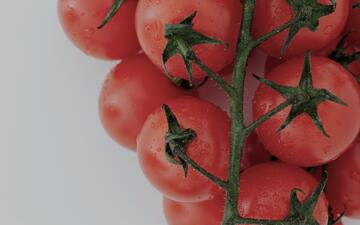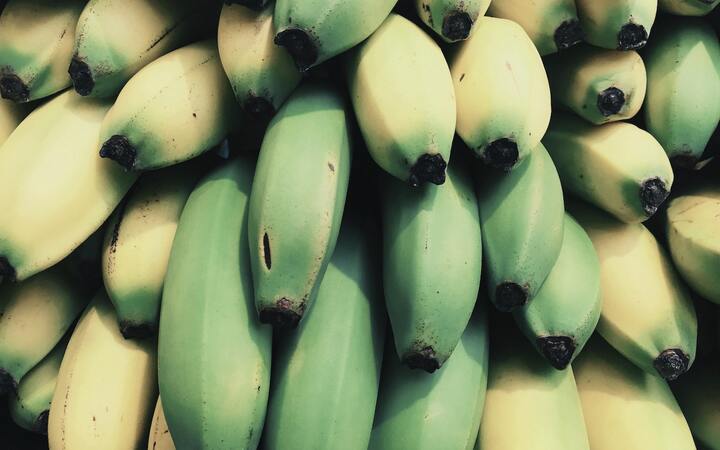Imagine you’re flying a plane full of babies. Initially, they’re all sleeping peacefully. But if one wakes up, they’ll start crying. That will eventually wake up some of the neighbors who will also start crying, and soon your plane will be an unhappy place. In this situation, you’d try very hard to keep all the babies asleep.
Last time we talked about ethylene. This is the gaseous plant hormone responsible for one bad apple spoils the bunch (true) and put avocados in a paper bag with bananas to ripen (also true) and many other less-known phenomena. Given ethylene’s importance, the agricultural industry has found many ways to manipulate it to make stuff better looking, better tasting, or easier to transport.
Ethylene gas is applied to many crops post-harvest.
Many climacteric fruits are picked unripe and then exposed to gaseous ethylene just before being sold. This is done to reduce spoilage and because it’s easier to pick and transport unripe fruit. It’s common for avocados, bananas, mangoes, honeydew, kiwi, mango, and tomatoes (Saltveit, 1999). (Sadly, I couldn’t find any numbers for how common.)
Although ethylene’s effects can triggered with concentrations like 0.1 ppm, it’s common to concentrations that are 100 or even 10,000 times higher. The usual procedure is to expose the fruit at a moderate temperature for between half a day and 3 days.
Myth: Ethylene just changes the color of tomatoes.
Here’s a common myth:
Tomatoes are picked green for shipping and then exposed to ethylene gas right before being sold. This changes the color but not the flavor.
Many (not all!) tomatoes are indeed picked green and then exposed to ethylene, which causes them to become red. However, this does change the flavor as well as the color. (See the next article in this series, all about tomatoes.)
If you don’t believe this, you can test it yourself: Get some green tomatoes and put half in a bag with some ripe apples or bananas. A blind taste test will show that they are sweeter.
Why do bananas go bad so fast?
Here’s a common question:
Bananas in the US mostly come from Central or South America. How is it that they can be harvested, washed, packaged, shipped across the ocean, and transported to a store while mildly green, yet suddenly after I take them home they go bad in a week?
Partly, this is just economics. Slower is cheaper. So, the invisible hand looked at the entire supply chain, found whatever part was cheapest to speed up, and repeated. As soon as the bananas were getting to you without rotting, it stopped.
But partly, the answer is ethylene. There’s lots of natural variation in how ripe bananas will be when they arrive at the destination. Some arrive while still very green. These are exposed to ethylene gas right before being sold, which starts the ticking clock that makes them go bad within a week or two.
People love ethylene-exposed citrus.
Since citrus is non-climacteric, ethylene does not ripen it. Nevertheless, ethylene is often used to degrade chlorophyll and thus change the color.
Consumers love this. Morales et al. (2020) took two types of mandarins. They harvested some while they were still green-looking and some after higher maturity. Then they treated half of each group with ethylene and asked people in Spain “would you buy these?”
| not treated | ethylene treated | |
|---|---|---|
| harvested early (type 1) | 2% | 53% |
| harvested later (type 1) | 12% | 82% |
| harvested early (type 2) | 32% | 72% |
| harvested later (type 2) | 56% | 70% |
This is a strong incentive for producers to use ethylene. The researchers also extracted the internal fruit and had people compare them by flavor. They couldn’t find a difference.
Myth: Oranges should be orange.
Did you know that the color “orange” was named after the fruit?
So, you’d be forgiven for thinking oranges should be orange. But no—an orange can ripen naturally on a tree and still be totally green. They only become orange when the temperature becomes lower, which causes the chlorophyll to degrade. Oranges in India or Brazil stay green even when perfectly ripe.
Nevertheless, people (in some places) expect citrus to be orange, so ethylene is used to “de-green” it. As citrus is non-climacteric, theory says this should have minimal effect on the internal flesh. This has been confirmed in oranges, grapefruit, mandarins, clementines, and suisho-buntan (a Japanese citrus).
A liquid ethylene precursor is also added to many crops.
It’s annoying that ethylene is a gas. In particular, if you wanted to apply ethylene to plants in the field, that would be hard. So, people looked for liquids that would be metabolized into ethylene after being added to a plant. In 1965 they discovered ethephon.
Remember, ethylene looks like this:
How could ethephon be a precursor to ethylene? When asked about this, the Dynomight Biologist—after some prolonged giggling at the idea that I thought I could understand biochemistry by staring at pictures of molecules—explained that the chlorine and phosphorus atoms easily get ripped off the two linked carbon atoms, that bond becomes a double bond, and voilà, ethylene.
Ethephon is applied to many different plants while they are still growing, including apples, cereals, cherries, citrus, coffee, cotton, cucumbers, grapes, guava, olives, peaches, peppers, pineapple, rice, sugarcane, sweet potatoes, tobacco, tomatoes, and walnuts (Saltveit, 1999). It’s approved by the EPA as a pesticide, though many of the applications are unrelated to pests.
How common is this? It’s very situational. For walnuts, it’s used in unusually hot or wet weather. For apples, it’s used for some varieties in some regions.
Here’s my best estimate for usage in the US.
| product | % using ethephon |
|---|---|
| Cotton | 60% |
| Tomatoes | 27% |
| Apples | 15% |
| Tart cherries | 70% |
| Sweet cherries | 10% |
| Rasins | 5% |
| Golf course grass (!?) | <5% |
| Peppers | <2.5% |
| Wheat, blueberries, blackberries, cantaloupe, pears, squash | <1% |
This is cobbled together from various sources.
Most of this information comes from this 2016 EPA report. Some additional details:
- More that 90% of ethephon is used for cotton. In total, 7.2 million acres are treated annually using 8.1 million pounds of ethephon
- The second most important crop is tomatoes, with 49k pounds applied to an 73k acres of tomatoes annually. It looks like there are a total of around 273k acres, dedicated to tomatoes, suggesting 27% of tomatoes are treated.
- I can’t figure out with tomatoes if ethephon is an alternative to ethylene gas, or if you might use both together.
- Here are the details on grapes.
- Table grapes: 30% (Did you know 99% of these are grown in California?)
- Rasin grapes: 10%
- Wine/juice grapes: <1%
- It’s apparently used on turf in golf courses to slow growth and… save work mowing? Typically used in spot treatments, e.g. near tees. The EPA estimate less than 5% is treated by acreage. The only other source of concrete numbers is Watada (1986), who states:
- Apples: Ranges from 1% to 60% depending on the region and the type of apple.
- Cherries: In the midwest, 90% of sweet cherries, and 25% of sour cherries.
- Blueberries: Only used on the last harvest of the season.
- Figs: Used on more than 50% of Calmyrna figs. (The most common type in California)
- Grapes: Used on 20% of grapes grown for raisins in California.
- Walnuts: Used with unusually hot or wet weather.
- Tomatoes: Used on 40% of tomatoes grown for processing in California.
Great effort goes into inhibiting ethylene production.
As far as the food industry is concerned, ethylene is as much foe as friend.
Remember your plane with the sleeping babies that wake up and start crying? This is basically what it’s like to move a container of bananas. If any of the bananas ripen anywhere, they will put out ethylene and start a chain reaction of ripening that will ruin the whole container.
There are several strategies to deal with this. The most obvious are refrigeration (to reduce ethylene production) and fresh air (to remove ethylene). These sound obvious but remember you have huge amounts of tightly packed fruit, and you need to prevent pockets of ethylene from forming anywhere. Also, using both refrigeration and fresh air at the same time will consume a lot of energy.
Another solution is to scrub ethylene out of the air. Some produce is stored and shipped using controlled atmosphere methods, where the mixture of gases is precisely tuned to maximize longevity (typically by increasing carbon dioxide, decreasing oxygen, and removing ethylene). Some fruit is packaged along with ethylene scavenging sachets.
A third solution is to inhibit crops from producing ethylene in the first place. The most common chemical seems to be Aminoethoxyvinylglycine (AVG), which blocks an enzyme that’s upstream of ethylene. In the US it is available as ReTain and is sprayed on fruits and vegetables preharvest to slow ripening. It’s approved for apples, pears, cherries, walnuts, pecans, apricots, peaches, and plums. In the EU, it is banned due to concerns of toxicity.
Great effort also goes into inhibiting ethylene response.
But maybe, on your baby plane, there’s no way to prevent some of the babies from waking up. If so, then perhaps you can still prevent the sleeping babies from hearing the cries of those that are awake.
That is, maybe you can’t keep all the ethylene out of the environment, but you can prevent your produce from reacting to it.
Here again, refrigeration can help, as can increasing the amount of carbon dioxide.
A more exciting option is 1-Methylcyclopropene (1-MCP), marketed as SmartFresh. This is a gas that binds to the ethylene receptors, preventing ethylene from having an effect. It is approved in the EU, US, and UK for many kinds of produce including apples, tomatoes, kiwi, bananas, melons, broccoli, and potatoes. Typically people expose produce to 1-MCP for a day or so, which blocks ethylene for a few weeks.
For long-term storage, 1-MCP might be applied repeatedly. This is so effective that things like apples are sometimes preserved for as long as a full year before being sold.
I’ve heard tell of some other chemicals that play a similar role, including silver thiosulfate; 2,5-norbornadiene and 5-Diazo-1,3-cyclopentadiene.
Even more adventurous ideas are to genetically engineer produce to make it insensitive to ethylene. (Of course, this wouldn’t work for climacteric fruit, which needs ethylene sensitivity to ripen.)
Some of this is allowed even on organic produce.
You’d think there would be some single database where you can see what’s allowed and what isn’t right? As far as I can tell, no—the government just expects you to read through a disorganized list of regulations each of which makes no sense unless you’ve read the entire chain.
Grumbling aside, the US National Organic Standards Board (NOSB) has a special list of synthetic (i.e. non-organic) chemicals that can be applied to produce which goes on to be sold as “organic”. Ethephon and 1-MCP are not allowed. However, ethylene gas is approved for postharvest ripening of “tropical fruit” and degreening of citrus. It’s also allowed to be used pre-harvest for pineapple flowering. It’s unclear to me exactly what “tropical fruit” means here, or how common this is in practice.
The health risks of ethylene processing seem minimal.
Should you worry about these chemicals? Probably not.
Ethylene gas. The EPA seems profoundly unconcerned. This gas was actually used as an anesthetic starting in 1923 with no reports of toxicity. It’s naturally occurring. But anyway, it’s a gas so it’s gone before anyone eats anything.
Ethephon. When ethephon is sprayed on plants, most is converted to ethylene, but some traces remain, and you eat them. It’s probably not good to consume large amounts of ethephon. Animal experiments show problems for the skin, eyes, metabolism, and kidneys. There’s no clear evidence regarding cancer. In the US, there are tolerances on how much ethephon can be sprayed on what types of produce at what stage of production. These are designed so that if a typical person eats produce for 70 years, they will only get 9% of the minimal dosage of ethephon that’s believed to cause any adverse effects. It seems that non-nursing infants have a much smaller margin for error, so that might be a valid concern.
1-MCP. This again is a gas, meaning almost all 1-MCP will be gone before you eat anything that was treated with it. In addition, animal experiments show very low sensitivity and scientists seem unconcerned about health impacts.
Some of the other chemicals (like AVG) might be more concerning, but I haven’t looked into them in detail.
Arguably ethylene processing is a big health positive.
My model of the situation is something like this:
Ethylene processing
↓
Produce is cheaper/tastier
↓
People eat more produce
↓
People are healthier
I mean, sure. You can imagine a world where society makes as much produce as we have now (and as appealing as we have now) without using these chemicals. In that world, perhaps people would be healthier because they avoided consuming trace amounts of ethephon, etc. But doing this would require lots of extra money, i.e. diverting resources away from other things that people like. The fact is, prices matter when people choose what to eat, and these chemicals make fruits and vegetables cheaper.







